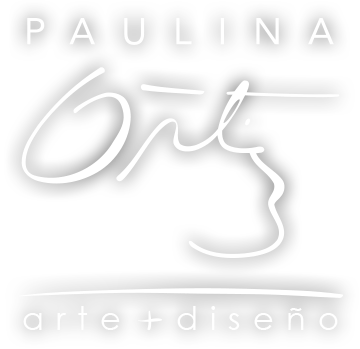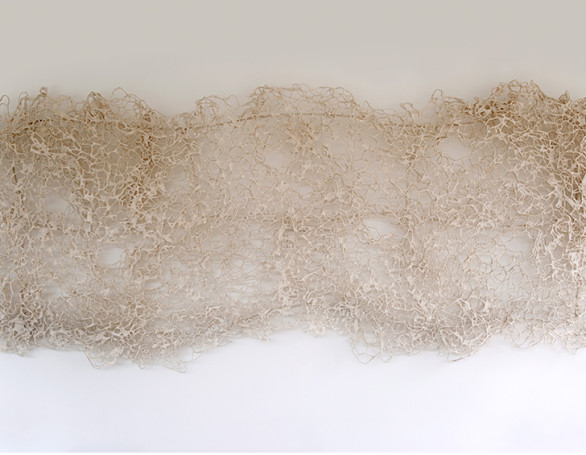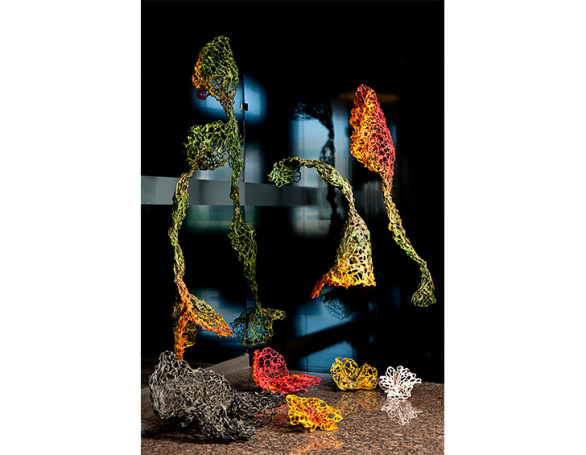“My ideas spring from the worlds through which I move, the intuitive and emotional fruit of a contemplation of the nature through which I walk and the more structured rationale of our active, exciting metropolis filled with enormous challenges.”
-Paulina Ortiz
Ma. Enriqueta Guardia
art historian and curator. 2015Paulina Ortiz has left a deep mark on Costa Rican plastic arts by bringing textile up from simple artisanry to the category of art and in turn bringing this into the modern world. She has remained faithful to the weaving itself, developing the many plastic qualities of its natural fibers, which she dyes and weaves with ancestral techniques, or incorporating other elements and joining together apparently dissimilar techniques to achieve amazing and perfectly integrated results. Her works are symbol and connection with modernity at the same time. Paulina has also contributed enormously to the dissemination of Costa Rican textiles as an artist, however, and she will be leaving an indelible imprint on textiles as an educator.
Dr Jessica Hemmings
textile writer and currently Professor of Visual Culture and Head of the School of Visual Culture at the National College of Art & Design, Dublin. 2009Professor Miranda Bruce-Mitford observes that, “The selection of the thread as a leitmotiv in Paulina Ortiz is not by chance. For western imagery it represents the umbilical cord between heaven and earth. The string is synonymous with hindrance and captivity but also the possibility of life; it is the symbol of human destiny.” This valid observation is applicable to much work made with textile materials today. But there are moments when Ortiz’s creations also feel connected to traditions as removed from Central American folklore to the East as the fates and their weaving are in the West. Contemporary Japanese textile art comes to mind. Scale, for one, is shared as well as a desire to be engulfed by an installation. But there is also an attention to immediate experience, finding meaning through a direct emotional response to materials. As a result, emotional currency rather than conceptual strategies prevail. When approached in this way, we are reminded that language poses no barrier at all.
José Mario Maza - 2005
Director Museo de Arte Moderno "Carlos Mérida" GuatemalaBajo la estructurada, exigente y profesional visión de la artista textil costarricense Paulina Ortiz, se presentan nuevos conceptos e ideas que nos asombran por novedosas y al mismo tiempo nos apoderamos de ellas por su pertenencia a nuestra cultura e historia. El arte textil y los "neotapices" como los bautiza Paulina, son pues, en este tiempo la muestra propia de una visión contemporánea y mundializada.
Pilar Tobón
Presidenta Organización Mundial de Mujeres en el Arte Textil, MIamiLa creatividad transmite vida, y la obra de Paulina Ortiz no sólo tiene ese poder vital, sino que también es dueña de esa fuerza interior que convierte sus piezas en ritos “quasi chamánicos” que nos remiten a nuestro yo más profundo, arquetípico y antiguo.
Victor Hugo Fernández 2004
Escritor y Crítico de ArteEsa es Paulina Ortiz: le gusta repicar y dar misa... Y qué? De verdad que lo hace con voluntad y convicción. Qué ricos son sus espacios de discreta apropiación cromática, pero intensos en todos aquellos otros valores vernáculos que demande la propuesta, desde iconografía precolombina, cabuya intervenida y provista de intencionalidad, hasta conceptos espacialistas contemporáneos y, en medio de todo ello, su determinante vocación a enfrentar estos desafíos con la preclara intención de quien sabe que la luz revela siempre el pulso exacto de aquellas combinaciones, combinaciones a su vez que solamente la argumentación plástica es capaz de articular.
Amalia Chaverri - 2001
Actual Viceministra de Cultura-Costa RicaPaulina Ortiz no ha claudicado en su pasión por el arte textil. Habiendo sido una de las más importantes introductoras y luchadoras por la consolidación de esta técnica, ahora es una de las más dignas representantes de esta técnica milenaria.
Elizabeth Barquero - 2001
Actual Directora del Museo de Arte Costarricense.Al recorrer esta exposición, constatamos que sus obras transmiten un sutil mensaje que sensibiliza al espectador con su entorno, expresado mediante un lenguaje simbólico producto de la creatividad, la investigación de técnicas tradicionales remozadas y conjugadas en un estilo personal de sensibilidad minimalista e indiscutible sello femenino.
Miranda Bruce-Mitford -2001
Profesora de la Escuela de Estudios Africanos y Orientales De la Universidad de Londres. Ella es también curadora del Museo BritánicoEntrar en contacto con el trabajo de Paulina Ortiz es acceder a un ritual de iniciación, es la forma de ingreso a la ruptura de normas y convencionalismos en la expresión artística, no solo textual sino también contextualmente.














